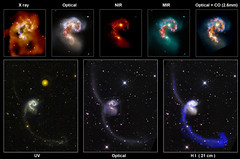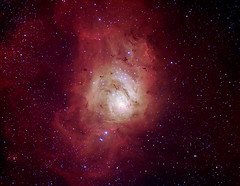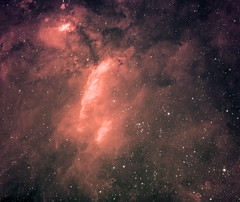Wolf-Rayet (WR) stars are the evolved descents of the most massive, extremely hot (temperatures up to 200,000 K) and very luminous (105 to 106 solar luminosities, L⊙) O stars, with masses 25 – 30 solar masses (M⊙) for solar metallicity. WR stars possess very strong stellar winds, which reach velocities up to 3,000 km/s. These winds are observed in the broad emission line profiles (sometimes, even P-Cygni profiles) of WR spectra in the optical and UV ranges. These strong winds are also attributed to atmospheres in expansion. Actually, these winds are so strong that they are peeling the star and converting it in a nude nucleus without envelope. Indeed, WR stars have ejected their unprocessed outer Hydrogen-rich layers. WR stars typically lose 10−5 M⊙ a year; in comparison the Sun only loses 10−14 M⊙ per year.

Hα image of the Population I Wolf-Rayet star WR 124 (WN8) showing a young circunstelar envelope that is ejected at velocities highest than 300 km/s. The chaotic and filamentary structure created forms the M 1-67 nebula. The star is located at about 4.6 kpc from the Sun. At the left, image obtained by the author using the IAC-80 telescope, combining filters Hα (red) Hα continuum (green) and [O III] (blue). The right Hα image was obtained by the Hubble Space Telescope WFPC2 (Grosdidier et al. 1998). Note that the large arcs of nebulosity extend around the central star yet with not overall global shell structure. Furthermore, numerous bright knots of emission occur in the inner part of the nebula, often surrounded by what appear to be their own local wind diffuse bubbles. The dashed square in the IAC-80 image indicates the size of the HST image.
This is Figure 2.1 in my PhD Thesis.
The mass-loss occurs via a continuous stellar wind which accelerated from low velocities near the surface of the star to velocities that exceed the surface escape speed. Their spectra, originated over a range of radii with the optical continuum forming close the stellar core and the emission lines in the more external areas (even beyond 10 stellar radii), indicate that the WR stars are embedded in luminous and turbulent shells of ejecta owing outwards at speeds comparable to the expansion velocities of novae although, in the case of WR stars, the expanding shell is being constantly fed with material from the main body of the star.
WR stars are extremely rare, reflecting their short lifespan. Indeed, they live for only some few hundred of thousands years, and hence only few WR stars are known: about 500 in our Milky Way and 100 in the Large Magellanic Cloud. Indeed, because of their peculiarities (brightness and broad emission lines), WR stars can be detected in distant galaxies. A galaxy showing features of WR stars in its spectrum is known as a Wolf-Rayet galaxy.
I compiled the main characteristics of WR stars in Chapter 2 of my PhD Thesis. A recent review about the properties of WR stars was presented by Crowther (2007).







